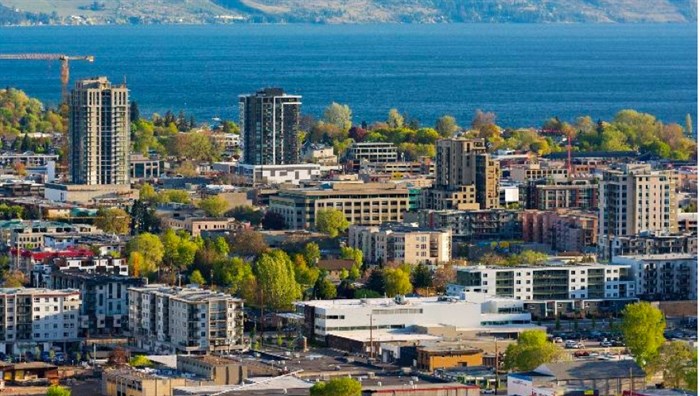How Kelowna can increase affordable housing despite record high building costs
“New buildings today are probably the most expensive buildings humans have ever built, notwithstanding palaces and such,” Mark Holland told Kelowna city council this week. “We have the highest standards ever in human history.”
Holland is the president of Vancouver Island-based Westplan Consulting Group who gave a presentation on behalf of the Urban Development Institute to council about the role of the development community in creating desperately needed housing.
“Folks will come to the (public hearing) microphone and say: ‘These new buildings, that’s great, I understand we need new housing, but they’re not affordable. Therefore, you shouldn’t approve them,’” he said. “Which really is an interesting conundrum for public policy.”
The province is pressuring local governments to pick up the pace of home construction and has got to the point of singling out 10 BC communities, including Kamloops, to set and meet growth targets.
READ MORE: Kamloops needs to tow the provincial housing line or go on its 'naughty' list
That’s all well and good but the reality of not only building more homes but of making them affordable to buyers or renters is, in many ways, beyond the control of those tasked with actually building them – the development community.
The process of building a home can take three or four years, starting with buying the land.
The developer has to know what can be built on that land but needs to pay for it long before they get approval to build.
Time and money go into designing a viable project that will not only win the support of local governments but of the banks as well.
Banks demand at least a 15% “margin” in order to finance a project and then will usually only put up 70% of the money.
That means, for example, a small apartment building of four storeys and 24 units could cost $10, of which the developer has to come up with $3 million of their own cash up front years before getting their money back.
Then there are the uncertainties of the cost of building materials. Not that long ago, Holland was dealing with a supplier of rebar who could guarantee its price for only 90 minutes, even though the builder wouldn’t need it for four years.
The shortage of land in many cities means developers have to do land assemblies, which drives up the cost of the land.
“We’re doing that all the time now because it’s so hard to find land,” Holland said. “You have to pay them so much money so they can find a better house, a nicer place, somewhere else because we need the land to do the project.”
Given all those challenges, it’s getting to the point where some builders are walking away from projects because they’re no longer viable.
There are things that local governments can do to help speed up the process and, therefore, make housing more affordable.
“Municipalities play the most important role in what land is available for where we put housing,” Holland said.
What cities can do is prezone as much land as possible to provide not only the certainty for developers knowing what they can build there but to also give local government control in how their cities grow.
The alternative is to have developers go in and try to change the community’s vision one parcel at a time.
Another major change is to have design guidelines so, again, the developer has some certainty about what will be approved because changes required later in the process cost time and money.
Given the price of land, financing, construction and all the other costs, private developers are not going to be building housing that is affordable for lower-income people, whether they be renters or buyers.
Local governments can help there by providing land for housing, but not to developers.
“I would encourage, with city owned lands wherever possible, to leverage your land value to carve more money out of the province and the feds and anything you can because you’re bringing a lot of value to the table,” Holland said. “Focus your land on those who are the lowest income. Using city-owned land to just provide middle income housing – I struggle with that. This is why we have homeless people all over the place. They’re falling through the cracks. Where there used to be rentals to support them, there aren’t now because they’re all just too expensive.”
Requiring builders to include some affordable units in larger projects doesn’t really work, he said.
If, for example, 10% of a 20-unit building had to be affordable that means the other 18 units will have to sell for more to offset the difference.
That has “unintended consequences” on the price of land.
When those higher priced suites sell, BC Assessment views them as the market norm, setting a new benchmark price for those type of housing units.
“They raise the land value and price of all the surrounding units,” Holland said. “The whole bar goes up and everybody’s land is now worth more.”
Which means, the base cost of the next project is higher.
Parking is another big factor in the cost of building but, Holland warned, Kelowna should not make the same mistake as Victoria.
“If you have a sixplex you need six parking stalls,” Holland said. “The banks get really uneasy in lending for a townhouse with no parking stalls. Council there (Victoria) chose housing and green space so you have to have 40-45% of the footprint of the lot as a building and another 40% has to be open space.”
Which leaves little or no place to park, other than on the street, meaning banks aren’t interested in loaning money to that builder.
“I don’t think they’ve had a single application in six to eight months in what was supposed to be the fast-track (to infill housing),” Holland said.
Kelowna, he said, is a leader in the province in that it prezoned many single-family lots to allow for fourplexes.
The city is going to add another 3,000 lots into that mix and they do have the parking requirements that the banks want in order to finance them.
READ MORE: Kelowna is doubling down on fourplexes
"Affordability for all housing comes long term,” Holland said. “You look at the affordable stock in your city today, it’s older buildings. It’s those great apartment buildings that were built in the '60s, those flat topped boxes. Brilliant housing. You could get a 900 square foot one-bedroom, two-bedroom. Very generous. They’re affordable now. When they were built, they weren’t affordable because they were new.
“Your affordability comes in two forms here. All supply is good because it helps stabilize prices so they don’t spike as much, even in the short term. But really, you need to build now for 20 to 40 years from now when you’re going to need it. Otherwise we set in place a chronic lack of housing.”
To contact a reporter for this story, email Rob Munro or call 250-808-0143 or email the editor. You can also submit photos, videos or news tips to the newsroom and be entered to win a monthly prize draw.
We welcome your comments and opinions on our stories but play nice. We won't censor or delete comments unless they contain off-topic statements or links, unnecessary vulgarity, false facts, spam or obviously fake profiles. If you have any concerns about what you see in comments, email the editor in the link above.










